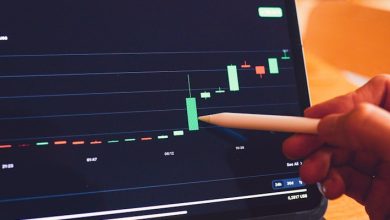What is Grid Trading? A Guide to Automated Strategies

- Understanding the basics of grid trading
- Exploring the benefits of automated strategies in trading
- How grid trading works and its key components
- Implementing grid trading effectively for consistent gains
- Common misconceptions about grid trading debunked
- Choosing the right automated strategies for your trading style
Understanding the basics of grid trading
Grid trading is a popular automated trading strategy that involves placing buy and sell orders at set intervals above and below a predefined price level. This strategy aims to profit from market volatility by taking advantage of price fluctuations within a specific range. By using a grid of orders, traders can potentially capitalize on both upward and downward movements in the market, regardless of the overall trend.
One of the key principles of grid trading is that it does not require predicting the direction of the market. Instead, it relies on the assumption that price will fluctuate within a certain range over time. Traders can set up their grid with predetermined entry and exit points, as well as stop-loss orders to manage risk. By using automation, grid trading can be executed 24/7 without the need for constant monitoring.
It is important to note that grid trading is not without risks. Because it involves placing multiple orders at different price levels, there is a possibility of incurring losses if the market moves in a particular direction. Traders should carefully consider their risk tolerance and use proper risk management techniques when implementing a grid trading strategy.
Exploring the benefits of automated strategies in trading
Automated strategies in trading can offer a wide range of benefits to traders looking to optimize their investment portfolios. By utilizing algorithms to execute trades based on predefined criteria, traders can take advantage of market opportunities without the need for constant monitoring. This can help reduce emotional decision-making and ensure a disciplined approach to trading.
One of the key benefits of automated strategies is the ability to execute trades at high speeds, allowing traders to capitalize on market movements quickly. This can be especially beneficial in volatile markets where prices can change rapidly. Additionally, automated strategies can help traders diversify their portfolios by trading across multiple assets simultaneously.
Another advantage of automated strategies is the ability to backtest trading strategies using historical data. This can help traders identify patterns and trends that may not be immediately apparent, allowing them to refine their strategies for optimal performance. Additionally, automated strategies can help traders save time by executing trades automatically, freeing them up to focus on other aspects of their trading strategy.
Overall, automated strategies can offer traders a competitive edge in the market by allowing them to execute trades quickly, diversify their portfolios, and optimize their trading strategies. By leveraging the power of algorithms, traders can take their trading to the next level and potentially achieve greater success in the market.
How grid trading works and its key components
Grid trading is a popular automated trading strategy that involves placing buy and sell orders at regular intervals above and below a set base price. This strategy aims to profit from the natural ebb and flow of the market by taking advantage of price movements within a specific range.
The key components of a grid trading strategy include setting a base price, determining the grid size, and establishing the number of orders to be placed within the grid. Traders typically start by selecting a base price at which the initial buy and sell orders will be placed. The grid size refers to the distance between each subsequent buy and sell order, which can be set based on market conditions and risk tolerance.
In addition to the base price and grid size, traders must also decide on the number of orders to be placed within the grid. This will depend on factors such as account size, leverage, and risk management preferences. By placing multiple orders within the grid, traders can potentially capture profits as the price fluctuates up and down.
Overall, grid trading works by creating a trading grid that allows traders to profit from price movements within a specific range. By strategically placing buy and sell orders at regular intervals, traders can take advantage of market volatility and generate profits in both trending and ranging markets.
Implementing grid trading effectively for consistent gains
To implement grid trading effectively for consistent gains, it is essential to carefully consider the parameters of your trading strategy. Set your grid spacing, take profit, and stop-loss levels based on thorough analysis of market conditions. By adjusting these parameters, you can optimize your grid trading strategy to adapt to changing market trends.
Additionally, it is crucial to monitor your trades regularly and make adjustments as needed. Keep a close eye on market movements and be prepared to modify your grid trading strategy accordingly. By staying proactive and responsive to market changes, you can maximize your chances of achieving consistent gains through grid trading.
Another key aspect of implementing grid trading effectively is to diversify your portfolio. Instead of focusing on a single currency pair or asset, consider spreading your trades across multiple instruments. This can help reduce risk and increase the overall stability of your grid trading strategy.
Furthermore, it is important to set realistic expectations and avoid being swayed by emotions. Grid trading requires discipline and a long-term perspective. By maintaining a rational and disciplined approach to trading, you can increase your chances of success and achieve consistent gains over time.
In conclusion, implementing grid trading effectively for consistent gains requires careful planning, regular monitoring, diversification, and discipline. By following these guidelines and staying committed to your trading strategy, you can increase your chances of success in the dynamic world of automated trading.
Common misconceptions about grid trading debunked
There are several misconceptions about grid trading that are commonly believed but are not necessarily true. Let’s debunk some of these myths:
- Myth: Grid trading is too risky. Truth: While grid trading does involve some level of risk, it can be managed effectively with proper risk management strategies in place.
- Myth: Grid trading always leads to losses. Truth: Grid trading can actually be profitable if implemented correctly and with the right market conditions.
- Myth: Grid trading is too complex for beginners. Truth: While grid trading may seem intimidating at first, there are automated tools and strategies available that make it accessible to traders of all levels.
- Myth: Grid trading is only for large accounts. Truth: Grid trading can be tailored to fit accounts of all sizes, making it accessible to a wide range of traders.
- Myth: Grid trading is not suitable for volatile markets. Truth: Grid trading can actually thrive in volatile markets, as it takes advantage of price fluctuations to generate profits.
By debunking these common misconceptions about grid trading, traders can better understand the potential benefits and risks associated with this strategy. It is important to do thorough research and practice with a demo account before implementing grid trading with real funds.
Choosing the right automated strategies for your trading style
When choosing the right automated strategies for your trading style, it is important to consider various factors that can impact your trading success. Different strategies have different strengths and weaknesses, so it is crucial to find the one that aligns best with your goals and risk tolerance.
One important factor to consider is the time frame you are comfortable trading in. Some automated strategies are designed for short-term trading, while others are better suited for long-term investments. Consider your preferred trading style and how much time you are willing to dedicate to monitoring your trades.
Another factor to consider is the level of risk you are comfortable with. Some automated strategies are more aggressive and can result in higher returns, but they also come with a higher level of risk. If you prefer a more conservative approach, there are strategies that focus on risk management and capital preservation.
It is also important to consider the market conditions and how different strategies perform under various circumstances. Some strategies may perform well in trending markets, while others excel in ranging markets. Take the time to research and backtest different strategies to see how they have performed in different market conditions.
Ultimately, the key to choosing the right automated strategy for your trading style is to thoroughly research and test different options. Consider seeking advice from experienced traders or financial advisors to get a better understanding of which strategies may be best suited for you. By taking the time to find the right strategy, you can increase your chances of success in the market.



